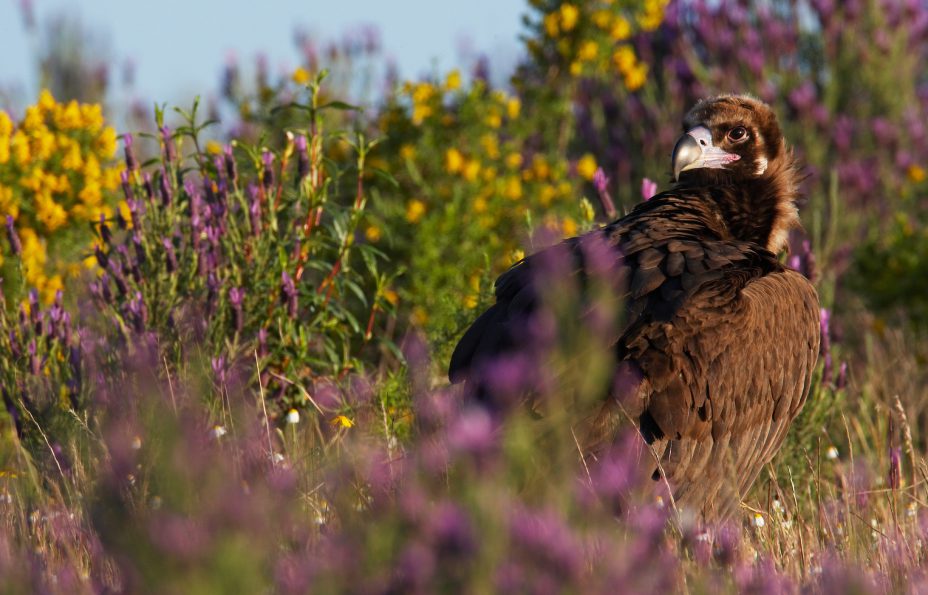The Cinereous Vulture, also known as the Eurasian Black Vulture is the largest European vulture, and one of the heaviest and largest raptors in the world, with its wingspan almost reaching 3 metres. The Cinereous Vulture faced a dramatic decline in Europe, but thanks to the increase of the Spanish population, the species is making a comeback in other parts of Europe, from Portugal to France and Bulgaria.

STATUS
The sight of Europe’s largest vulture soaring in the skies is one that became rare over the 20th Century as a result of a combination of illegal wildlife poisoning and reduction in the availability of food. Cinereous Vultures are particularly sensitive to human disturbance, especially during the breeding season and the destruction and changes of habitat had a significant impact on populations in Europe. The species has become extinct in many countries across its range leaving the remaining population split in two, a Western population on the Iberian Peninsula and an small Eastern population found in Greece.
From a historic low point the population of Cinereous Vultures has been steadily recovering since the 1980s and a 2018 survey of the European populations shows an increasing trend in number of breeding pairs. Measures to protect wildlife from wildlife poisoning have resulted in a rapid recovery of the species in the Western population. Efforts to reintroduce Cinereous Vultures began in France in the 1990s which has seen the species return to the south-west part of the country and in 2018 the Eastern population is being strengthened with the Vultures Back to LIFE project saw the first releases of the Bulgarian reintroduction project.
| Genus | Aegypius monachus |
|---|---|
| Common name in other languages | Dutch: Monniksgier; German: Mönchsgeier; French: Vautour Moine; Spanish: Buitre Negro; Portuguese: Abutre Preto; Swedish: Gragam |
| IUCN Red List Status (Europe) | Least Concern |
| Left in the wild | 16,800 – 22,800 mature individuals worldwide (BirdLife International 2021) |
| Breeding pairs | 2,739 – 2,749 breeding pairs in Europe (Vulture Conservation Foundation 2022) |
| Breeding behaviour | Monogamous pairings |
| Range | Spain, Portugal, France and Greece |
| Habitat | Forested areas in hills and mountains |
| Size | 98-120cm |
| Wingspan | 2.5-3.1m |
| Weight | 6.3-11.5 kg |
| Diet | Feeding on carrion from medium-sized or large mammal carcasses such as rabbits, wild and domestic herbivores |
| Life expectancy | Up to 35 years in captivity |
FEATURES
The Cinereous Vulture is one of the heaviest and largest raptors in the world. It is a dark brown and broad-winged species with a slightly wedge-shaped tail. The bald head and neck are a bluish-grey, with a fluffy collar which is lighter in older birds. In many countries, this bird is called ‘monk vulture’, because of it’s upright standing neck feathers that resemble the hood of a monk.
DISTRIBUTION
In the last two hundred years, the cinereous vulture greatly decreased in numbers in most distribution areas, especially by poisoning, habitat destruction and reduction of the food supply. In many European countries (Portugal, France, Italy, Austria, Poland, Slovakia and Romania), the species became extinct. Thanks to strong efforts in many different projects (e.g. the protection of breeding sites, taking actions against poisoning, restoration programs), the numbers are now slowly increasing, especially in Spain, where the population is now of more than 2,000 pairs. Furthermore, in France a successful reintroduction project has resulted in the re-establishment of the species (25+ pairs), Greece (around 28 breeding pairs in the only remaining colony in the Balkans). The total European breeding population (including Turkey and Russia) is approximately 1800 pairs.
BEHAVIOUR
The cinereous vulture nests in trees and sometimes on cliffs. Like most other vultures, cinereous vultures are monogamous. Couples build huge nests that are reused each year. Eggs hatch in 50-55 days. Cinereous vultures have a specialised type of haemoglobin in their blood, allowing them to effectively absorb oxygen even at great heights. On thermal winds they ‘float’ to these great heights in search of carcasses.
ACTION PLANS
Species Action Plans are very important strategic documents that frame the priorities for further species conservation work. They are created by conservation partners, scientists, charities, governments and local groups and are tools for identifying and prioritising measures to restore the populations of vultures across their range. They provide information about the status, ecology, threats and current conservation measures for each species of vulture and list key actions that are required to improve their conservation status.
The Vulture Conservation Foundation co-developed the Vulture Multi-Species Action Plan (Vulture MsAP), which was adopted by the United Nation’s Convention on the Conservation of Migratory Species of Wild Animals (CMS), aiming to conserve all 15 African-Eurasian vultures species, including the Cinereous Vulture. are found. Further, the VCF updated old species actions plans together with partners within the LIFE EUROSAP project, including the European Species Action Plan for the Cinereous Vulture.